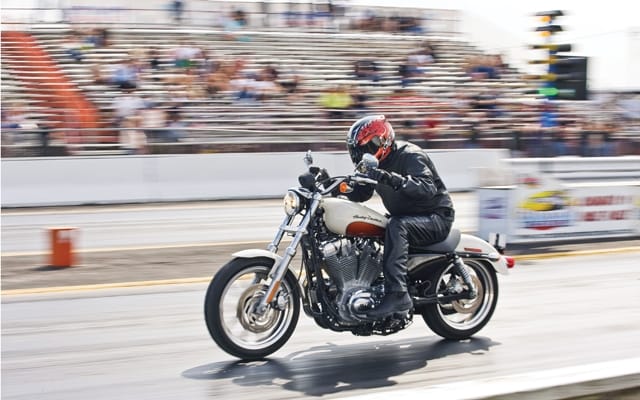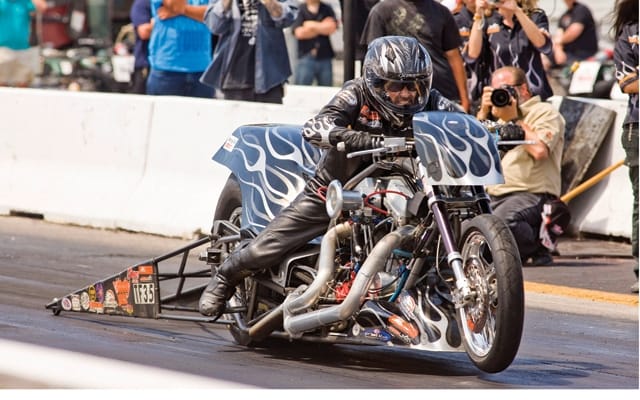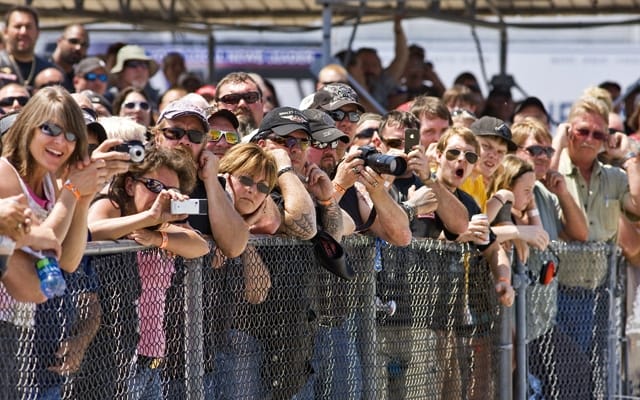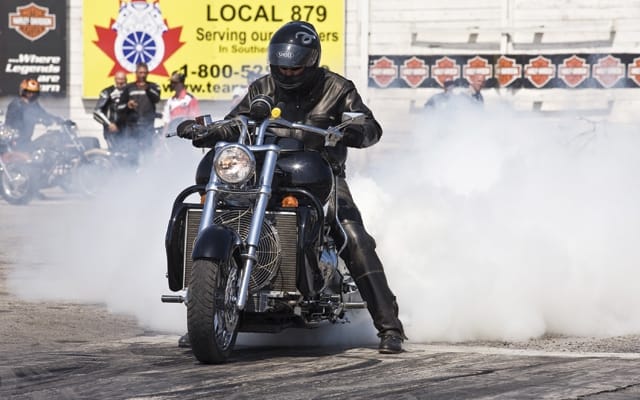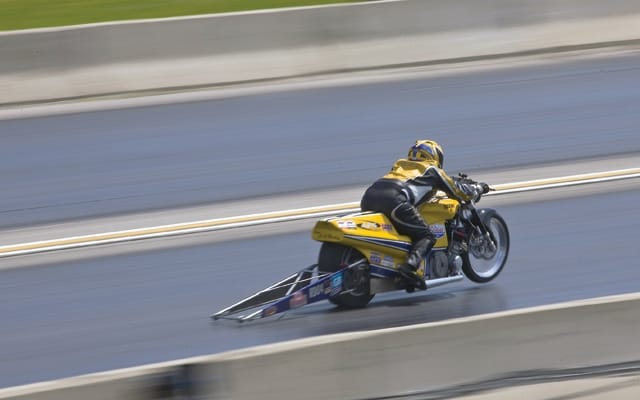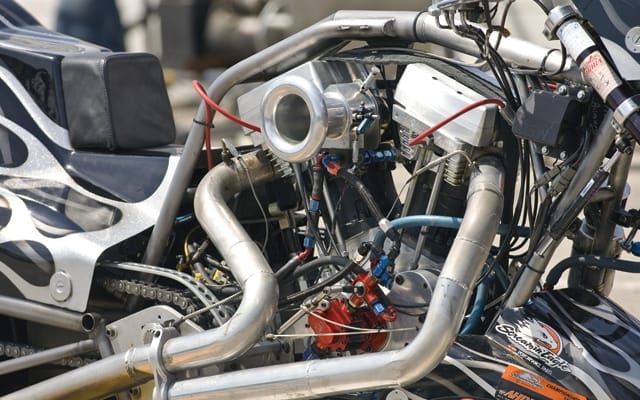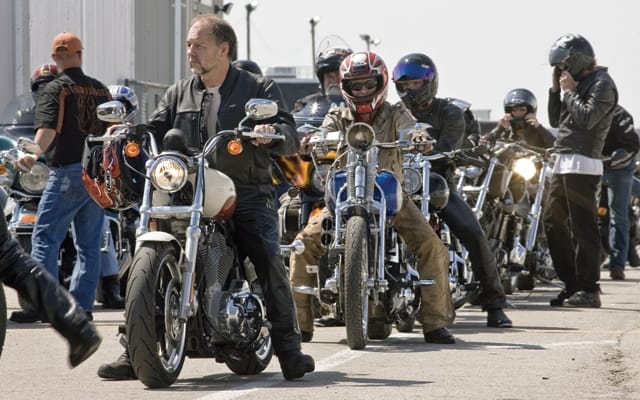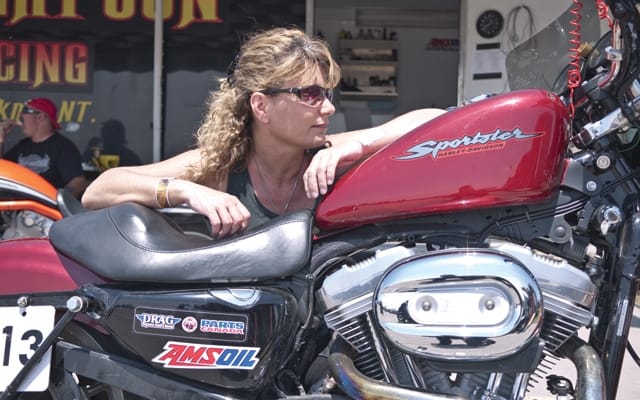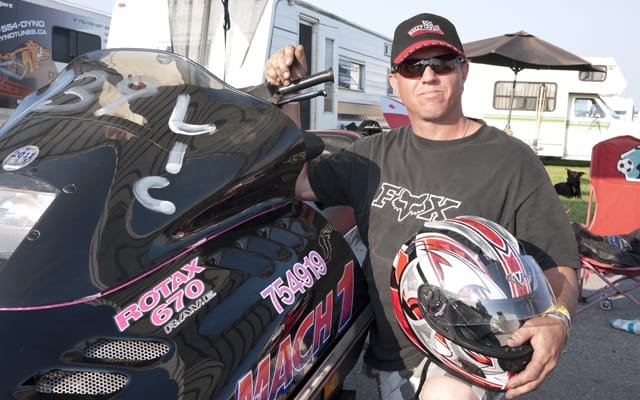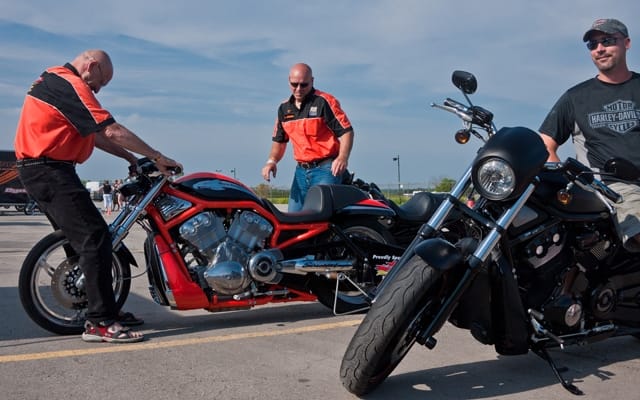Steve Thornton takes Harley’s 883 Superlow to the dragstrip and can’t quite hold it back.
June 19: A hot day in Grand Bend — a hot day and a loud one. Nitromethane-fuelled Harleys 12 feet long and as close to the ground as a shadow sit by the start line, engines rumbling. People loiter behind them, young men and women in shorts and flip-flops, tats and sun-browned skin sparkling in the clear air.
One of the racers opens his throttle to spin a fat rear tire, make some traction. Sound spills from the open-piped dragbike, a coughing roar that seems able to rip the pavement under you. People turn away in sudden pain, grey-white smoke billows up from burning rubber and drifts toward them. The big race engine relaxes to a lumpy idle, the noise falls away, and there emerges a stunning tableau: people standing on the track, facing me with hands over their ears, backdropped by a thick cloud of smoke that fills all the spaces behind and between them. I wish for a camera.
I can’t have a camera, of course. I am on the waiting line, standing beside my drag bike, a Harley 883, waiting to throw down with the guy next to me. This is an eastern round of the Canadian Motorcycle Drag Racing Association season, and I’ve been given a motorcycle and an entry card. Just let me lose, I think. Let me lose this race and then go home and relax. I’m hot, I’m tired. And I think my ears are bleeding.
I know nothing about this drag racing business, except that it is the most elemental form of racing, and that the hard part is getting launched. I picked up the pretty little Sportster a couple of days ago, rode it five hours from Toronto to the serene, green countryside near the bottom of Lake Huron. “You’re going racing,” Neil had said. Then he laughed. “Drag racing.”
The Sportster — it’s a new model, the 883 Superlow, and it was well-named — has surprised me. Sitting in it for the first time, I felt like I had gone to kindergarten, sat down at one of the kiddie desks. I expected performance about equal to that of a 250 Honda we were also testing, but the Harley-Davidson had more than that. As I pulled onto the highway, I found that the 883 was cheerfully able to gun up to local traffic speeds. And that it was actually quite comfortable. The illusion that my knees were knocking against the sides of my helmet was just that. An illusion.
I had thought that I might come home with a trophy. How many 883 racers could there be? And wouldn’t these guys be raw amateurs, barely able to get a motorcycle through an intersection without stalling? I expected, that is, to race in the slow class, against a bunch of dorks.
“We don’t have enough 883s to make a class,” Dino told me. Dino runs the event at Grand Bend. He’s a big guy who wears shorts and rides around in a golf cart. “You’ll be in Harley ET.”
Great — I’m going up against V-Rods and big twins, maybe the odd 1,200 cc Sportster or Buell. But I still have decades of experience riding motorcycles. How hard can it be to launch a bike on a drag strip?
Well, first, there is the Christmas tree. Why they can’t just get some guy with a pistol to stand out there, I don’t know, but that damned Christmas tree ain’t no gift to me. I cannot figure it out. The light turns green, I make what I think is a decent start, run as hard as I can, turn in a time of 15.569 seconds. Terrible, and it’s not until I’ve made several passes that I even think to look at my R/T. But it turns out that the R/T is important; it’s the time that passes between the flash of the green go light and the movement of your race bike: reaction time.
June 18. Morning: Paul Guerrieri strolls out from behind a tent where two drag bikes are parked, orange V-Rods. One is a Destroyer, a 165 hp Harley-Davidson-built dragster with a wheelie bar; the other is a regular V-Rod, except that the exhaust pipes have been opened up and a shift light and button have been installed, the idle set to about 2,500 rpm. He says I can ride that one, race it. I back away, no thanks, but then I do it. This is Saturday and it’s open practice. I’m running slow on the 883, can’t seem to get out of that 15-point-something zone. Paul’s V-Rod is loud and won’t turn corners very well, but it should run at 11 seconds or so. My turn comes and I’m a little better at the start, but then I’m no good at the shift button. The red light over the instrument console flashes and I stab the button, nothing happens, the light flashes again. The motor cuts out, over-revving. I finally revert to shifting the normal way and finish at 16.029 seconds, slower than I was going on the Sportster. I give him back his bike and say thank you, but I blew it. He laughs — he’s having a great time at the drags. He’s a real estate broker, rides in the Destroyer class and says he still gets nervous, red-lights the start, goes all over the track, makes all kinds of mistakes.
Later, I watch him race on his Destroyer. He cuts a 9.6 ET, his best ever, but loses the race.
The 883 has a short redline. I keep running into the rev limiter, hearing the engine rattle and gasp. On the highways coming out to Grand Bend I tried shifting without the clutch, and it’s easy; the little Harley-Davidson seems to have a well-sorted transmission. I can even downshift without declutching. But now, as I practise on the drag strip, I’m using the clutch, not thinking about technique, just trying to get launched properly. My R/T numbers are consistently bad: point-fives and point-sixes, and my 1/4-mile ET is slow: 15.030, 15.115, 15.548. I’m losing every practice round.
I’ve been told to leave on the last yellow light. The Christmas tree has two yellow lights at the top. There is no line at the starting point, but when you’ve moved into position, when you’re staged, these two yellow lights will turn on. More yellow lights are placed vertically below the staging lights. They flash sequentially, and then a green lights up, so quickly that if you go when the last yellow comes on, the green will light before your wheels can move. So go on that last yellow.
But I can’t. I keep seeing that damned green. I close my eyes, imagine the lights, imagine myself going on the yellow, and late in the day I’m sitting on Paul’s V-Rod, staring at that yellow light, my trigger. I pull off a .253. I’ve cut my R/T in half — and it’s still too slow.
June 19. Morning. My first run scores an R/T of .456 and a 1/4 mile ET of 15.399. I talk to myself, do some mental imagery, and 25 minutes later, I’m at the start again, staging. With a form of concentration that is vital and immediate I stare at that unlit yellow. Nothing else exists, no crowd, no competing motorcycle, not even a motorcycle under me. The staging lights illuminate, and very soon, perhaps in one second, yellows will ripple down the Christmas tree. I open my throttle. Yellows flash and I go. At the end of the track, I get my timing slip. My R/T is .141, the best yet. I made a dumb mistake, pulled in the clutch lever for a moment as I was launching, ruining my momentum, so my ET sucks, but I’m happy. I am making friends with the Christmas tree.
I keep improving. R/T .096, though my 1/4 is 15.510. I backslide — .433 R/T — but only briefly. Next R/T is .013, then .087. My 1/4 times are still slow, 15.324, but I start thinking.
What else do I have to do? I’m launching well, but I need to go faster.
I’m shifting gears three times in the race, getting into fourth before the end of the quarter mile. And before every shift, I hit the rev limiter, which cuts power. So I need to shift sooner. There’s no tach on the Sportster Low, but I can feel the engine, so I’ll try. I also think that I may not be holding the throttle fully open. I will rack it to the limit before my start and keep it there.
There is a guy here from Yellowknife, Jeff Pitre. He races Destroyer, but his wife, Liz, has an 883. I want to ask her why she races, what she gets out of it. Before I can speak to her, they call Harley ET. It’s show time.
I have set my dial-in time. I had hoped to break into the fourteens, but that is not happening. I have tried to focus on the last yellow, to keep the throttle pinned on the launch, to shift early on the run. But it’s hard; the mind does not want to concentrate on more than one thing. So my dial-in, my estimate of the best time I can run, is 15.25 seconds.
I line up for my first elimination round, and there beside me is Liz, with her 883. We talk, the guys in front of us race, she tells me that she had a get-off on a Destroyer, broke a bunch of bones, is racing the 883 while she mends.
We’re up. I get the left side. Stage. Liz stages. Lights flash.
My R/T is great, .068, better than Liz’s, and my ET is better than hers, too. But she wins. I have gone 15.118. I am out.
This is bracket racing, and while it seems to make no sense that you can lose by going faster, it is a logical way to dispose of the variety of motorcycles you will get at a race like this. We’ve got 20 or 30 competitors and a range of about 100 horsepower from weakest to strongest. I could end up against a bike that goes five seconds faster in the quarter. How to make that fair? Handicaps.
Your dial-in time is guesswork: what’s your best possible time? If you have a slow dial-in time and go up against a faster rider, your light will flash green before his. The slower your dial-in, the longer the interval between your green and his. But if you set it too slow, and if you race with any sincerity, you’re likely to break-out — beat your dial-in — and you will lose the match. In theory,dial-in times make all bikes equal.“You win bracket racing with reaction times,” I had been told. And I was getting better at reacting. But I wasn’t very good at figuring out my dial-in. It cost me my first race.
But you can buy back in for $20. I am tired and it is hot, but I think, one more, I have to give it one more shot. Just let me lose. Let me lose the race and then go home and relax. I’m hot, I’m tired, and it’s awfully damn noisy out here. I go to Racer Services, change my dial-in: 15-flat.
On the line, I’m against a guy on a yellow bike that has Iron Horse written on the gas tank; it might be a Sportster. We stage. Lights flash, I burn what feels like a good R/T and a decent 1/4. At the end of the track, I pick up my timing sheet and look at it.
Ho. Ly. Shit.
My R/T is .087, pretty good. And there’s my time, 15.14 seconds, not bad, considering. And there beside my time is something I had not expected: WIN.
Next round, I race by myself. It’s called a “bye.” There’s an odd number of racers so someone has to step out for a bit. “You can red-light,” a guy tells me. “You can break out, you can do any damn thing you want and it doesn’t matter. You’re coming back.” So I run by myself and when I see my timing slip, I’m excited. ET is 14.99, which I had not thought I could do. But then I notice a minus sign in front of my R/T. I have a negative reaction time; I red-lighted. And yet, there it is: WIN.
It’s 4:06 p.m., and there are not so many of us left. I have forgotten that I wanted to leave early. All I want to do is race. I have reset my dial-in to 14.8, just to be safe. I’m up beside a guy on a Buell, concentrating like mad on that yellow trigger. I go.
.096 R/T, 14.894 ET. WIN.
I almost kiss the guy at the timing shack. Not only am I still in the running, but I have learned how to launch this thing and I have broken into the 14-second range.
Now there are four of us left. I have somehow made it to the semi-final round, and I’m up against a guy on a V-Rod. I have left my dial-in at 14.8, knowing that there’s no way I’m going faster than that.
We stage. I want to win. I want that trophy. I want to be the guy who races against the other guy at the end of it all. I concentrate. Yellows flash.
My R/T is .058, pretty good. My ET is 14.751.
On the ride home, I feel good. I have not won, but for a first-time rookie to get within two races of taking home a trophy is something. And I have made times that I thought were impossible. I’ve been teased. You’ll be telling every manufacturer that gives you a bike from now on that you’re taking it drag racing, I’ve been told.
The 883 Superlow does not win me over on the ride back to Toronto. There are some things I like: its speedometer is eminently sensible, with a button on the back side that you press to change the odometer to a clock or a trip meter. The footpegs are not way out front. The exhaust system emits a lovely muted roar when asked to. But there is no windscreen and on the 401 at 130 it’s punishing; the 401 is not a quarter-mile long (and I never did hit 130 on the track; my best speed was my last run, 88.92 mph). My arms are sore, my hands are sore. Where the highway is disturbed by a series of ruts and bumps, the suspension is harsh, jarring me painfully. The rear suspension’s spring preload has been set at minimum, which will reduce shock absorbing abilities, but still, these are deficiencies. Those footpegs are sensibly located in the fore-and-aft dimension, but they are way out there sideways, far enough that sometimes I lift my foot from a peg at a stop, go to put it down, and land it right back on the peg, almost causing a tipover.
But hey, all things considered, this little Sportster Superlow does pretty good. It has an engine with heart, it has brakes that work well, and it’s pretty. The seat is decent and the steering response is quick and stable. Like I found out at Grand Bend, it’s hard to get everything right. For a lot of riders, the Sportster 883 Superlow will be a start.And as every drag racer knows,if you want to have a good time, you need a good start.
